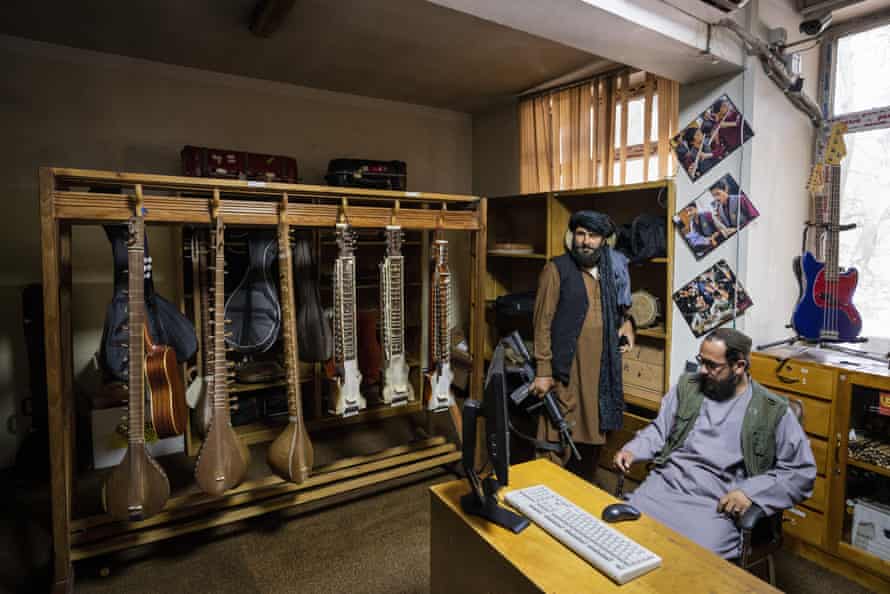[ad_1]
The musicians of Afghanistan have again been silenced by the Taliban. Other than specific religious and patriotic forms and contexts, the group believe that listening to or making music is morally corrupting. If there is anything to the Taliban’s credit here, it is that they recognise music’s potential to shape our subjective experiences, transmit ideas and build and strengthen communities. Since the group’s return to power in August last year, musicians have been murdered and brutalised, wedding parties have been raided, and centres for music learning have been closed.
I first visited the country in July 2018 to meet the members of the Afghan Women’s Orchestra at the Afghanistan National Institute of Music, the specialist school set up in 2010 by Ahmad Sarmast and which – before its forced closure last July – had 350 students. For three years I gave weekly online lessons to the young conductors, men and women, at the school. These lessons had their challenges, not least the regular power cuts and slow internet speeds in Kabul, but they gave me a tantalising insight into the orchestras, repertoire and rehearsal practices of the young ensembles at the school, opened my ears to the unique sounds and forms of Afghanistan’s orchestral music. Above all, I was reminded yet again that orchestras can and do change lives.

The people of Afghanistan have been, are, and always will be, profoundly musical. The country’s music traditions go back thousands of years and have flourished in dialogue with their Persian and Hindustani neighbours in the south and the people of the areas of Uzbekistan, Tajikistan and Turkmenistan in the north, as well as with European and American popular and classical music, which circulated in and out of the country throughout the 20th century. The celebrated singer Ahmad Zahir (1946-79) perhaps most notably epitomises the prolific blending of these diverse musical influences, inspiring generations of musicians.
The orchestras of Afghanistan, too, have a rich history stretching back nearly 100 years. In the latter half of the 20th century, orchestral music-making flourished alongside a boom in radio and television broadcasting. Large, conducted ensembles – playing western as well as local music, both new and old – became a central feature of the musical landscape. The country’s orchestras are unique in that they usually encompass a fusion of traditional instruments, such as the Afghan rubāb (a short-necked plucked lute – often considered the national instrument – which has three main strings, two or three drone strings and up to 15 sympathetic strings), the Herati dutār and the Afghan tambūr (both long-necked plucked lute instruments) and tabla (hand drums), alongside those of European heritage.

The wars that engulfed Afghanistan from the 1970s to the 90s curtailed music-making substantially (the first Taliban takeover in the mid-90s instituted complete musical censure until 2001), but in recent years, a new era of orchestral music-making had been taking shape, with young composers, conductors and musicians establishing new repertoire and new visions for these ensembles. These emerging musical voices were all abruptly silenced last summer, when the Taliban regime returned.

The world now has a new opportunity, however, to hear from those musicians forced into exile and even from those in Afghanistan who – under threat of brutality and even death – continue to make and share their music from hiding. A concert at this summer’s Spitalfields festival in London will mark the first time that a British orchestra has performed a programme of Afghan orchestral music. I have co-curated the project with composer and pianist Arson Fahim to celebrate Afghanistan’s history of orchestral music-making and provide an international platform for the flourishing creativity of the country’s composers and musicians.
The Oxford Philharmonic Orchestra, under my direction, will be joined by musicians playing traditional Afghan instruments to premiere newly commissioned works by eight Afghan composers.
These composers represent some of the most exciting new compositional talent to come out of the country in the past decade. They were given the opportunity to write for a small orchestra of European heritage and Afghan traditional instruments, and their works will give listeners a glimpse into the lives and experiences of these young musicians, the people and music of Afghanistan.

Milad Yousufi’s composition Nostalgia draws on the act of remembrance within his Sufi faith, evoking his profound sense of longing for his homeland and his family. Arson Fahim’s Dance of Terror explores his experience of the past two decades of conflict. Meena Karimi’s work for cello and orchestra, Dawn, “represents the story, struggles, strengths, and pain of women and girls in Afghanistan” and has been left unfinished in order to “tell the truth” about women’s rights in her homeland. She will only complete her work “when all Afghan women have achieved their dreams and rights”, she has said. Qambar Nawshad’s Hope reminds us that hope is essential to life. “Hope in human life is as valuable as wings are for a bird. Without it, life would be meaningless – imagine a body without soul and movement.”
For all these young musicians, the value of orchestras is immeasurable. They bring players from different musical, cultural and ethnic backgrounds in Afghanistan together as well as being a cultural bridge between Afghans and audiences outside the country. They provide important platforms for the collective expression of musicians’ shared values of social justice, gender and ethnic equality, personal liberty, and freedom from violence and oppression. For Afghan’s young musicians, orchestras offer an opportunity to spread a message of peace and hope at home and internationally.
[ad_2]




